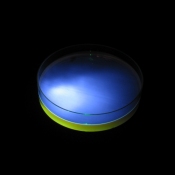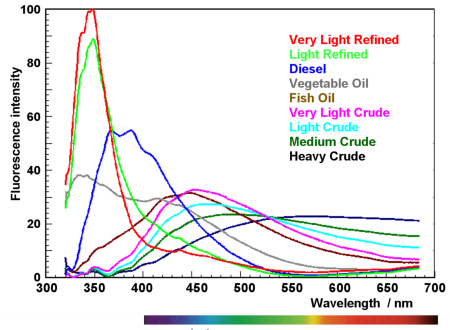Le fluorodétecteur à laser (2/5, en anglais)
The Laser Fluorosensor (2/5)
Detection and classification of oil spills
Oil belongs to the substances which absorb light and re-emit part of it as fluorescence. The degree of absorbance is strong in the ultraviolet and decreases monotonically with increasing wavelengths in the visible range (blue, green yellow, red). Since absorbance and fluorescence are connected with each other, the intensity of fluorescence emission decreases with increasing wavelength as well. Strong fluorescence emission makes it easy to detect oil. Therefore, pulse lasers are utilised with emission wavelengths in the ultraviolett at about 250 to 350 nm.
The photographs below, taken in the laboratory, depict the bright fluorescence emission of lubricating oil when illuminated with UV laser radiation at 355 nm. This effect makes it possible to detect oil on the sea surface with a laser fluorosensor operated aboard an aircraft.


Laser radiation is characterised by a very small bandwidth: the spectrum is a sharp line. This is called monochromatic radiation, see chapter 2 of the tutorial on Remote Sensing Using Lasers. The fluorescence of oil has a comparably much larger bandwidth. As a rule, fluorescence emission spectra always have higher wavelengths than those of the exciting light. Their shape, i.e., the intensity as a function of wavelength, differs for different oil types.
Light oils such as petrol and Diesel fluoresce at ultraviolet or blue wavelengths. Heavy oils which appear dark brown or black and absorb light strongly fluoresce less intensively, and their emission covers the entire visible spectrum.

The graph above depicts the differences of fluorescence spectra of several oil types. These oils can be detected with a laser fluorosensor, and classified by analysing their fluorescence spectra. In particular, less harmful vegetable oils and fish oil can be distinguished from mineral oils.
You will find more information on the molecular properties of fluorescence in supplement 2, chapter 7 of the tutorial on Remote Sensing Using Lasers.
